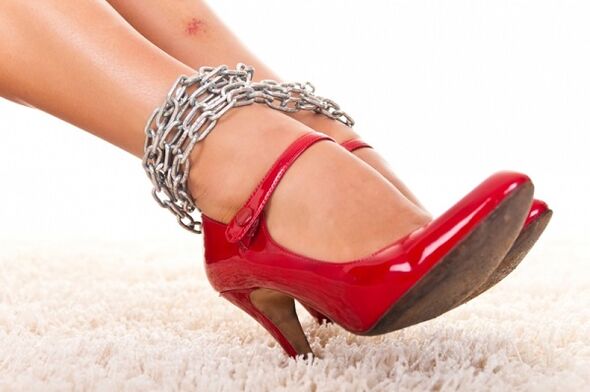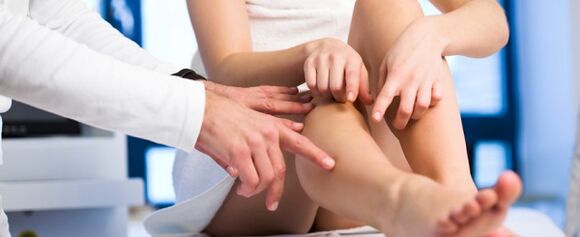Varicosis is a pathological condition, the result of chronic venous insufficiency, in which the venous walls become thinner, the lumen of the veins increases and the expansion (nodes) aneurysm are formed.Visually, the veins become very swollen, blue in color, winding.It is manifested by a feeling of severity in the legs and their fatigue, edema of the feet and legs, nightly convulsions in the legs.
The causes of varicose veins
It is impossible to name a specific reason, but there are a number of factors, which can cause an increase in pressure and a decrease in the elasticity of veins, as well as the weakening of the valves, as a result of this, varicose veins develop.
In clinical phlebology, a number of provoking factors leading to varicose veins are distinguished:
- Work on the legs or a long stay in a standing position.
- Using socks with strong elastic bands that squeeze the legs.
- Weakness of tissues as a result of congenital features.
- Directing.The legs have an increased load of the whole body.This factor is dangerous for people whose work involves prolonged standing.
- Genetic predisposition.If parents had varicose veins, then a child with a probability of 70% will also have the development of pathology.True, risks can be reduced, avoiding their appearance.To do this, you just need to not create provoking factors.With a genetic predisposition, varicose veins appear very early.
- Life.If a person is not active enough, then the risk of varicose veins increases.PHLEBOLOGISTS call a similar state “computer varicose”.
- Hormonal malfunctions and bearing the fetus.During pregnancy, varicose veins develops due to an increase in blood volume, as well as squeezing the veins that increase in the size of the uterus.In hormonal failures, the production of progesterone and the reduction in estrogen synthesis increase, which increases blood coagulation.
- Obstacles of the outflow of blood.This condition occurs with the formation of blood clots, the development of tumors.
- Obesity.Excess weight enhances the load on the feet, the malnutrition of blood circulation begins, and extra pounds cause an increase in abdominal pressure, which changes the outflow of blood.
- Diabetes.In case of disease, a high sugar rate begins to damage the vascular system, which leads to the formation of blood clots.
- Stress and nervous disorders affect blood vessels, lead to the development of varicose veins.
- Alcohol abuse.Alcohol is capable of bending the body, and with excessive consumption, the blood thickens, blockage of veins and malnutrition of blood flow begins.
- Unstable nutrition.If the body does not receive vitamins C, E, P, as well as useful trace elements: blood circulation is disturbed, the state of blood vessels worsens, which leads to varicose veins.
- Frequent stool delay.In this case, abdominal pressure increases, and the outflow of blood in the legs is disturbed.
- Pathologies of the kidneys and heart.
- An overdose of drugs to increase blood coagulation.

Depending on the cause of the development of the disease, 3 main stages of varicose veins can be distinguished:
- Compensation.
- Subcompensation.
- Decompensation.
Varicose veins do not apply to serious pathologies, but scary with its complications.
Pay attention!If the disease appears, then it will not pass on its own.Untimely appeal to a specialist leads to serious violations, which pose a danger.
The main symptoms of varicose veins
The clinical picture of varicose veins is not difficult, this allows a phlebologist to quickly make a preliminary diagnosis and direct the patient to instrumental diagnosis.

Among the main signs of varicose expansion, they distinguish:
- The emergence of swelling on the legs by the end of the day, on the evening.The very first symptom is among the possible, especially when wearing tight shoes.After normal rest in the morning, swelling disappear.
- Heaviness in the legs.A person feels not just severity, but bursting in calves, especially after a working day.A symptom more often appears in people with sedentary work.If you spend walks in the evening and provide a good rest, the signs disappear in the morning, but in the evening they reappear.
- Strong heat in the legs, namely in calves.
- Convulsions at night that reduce caviar.
- The appearance of a vascular mesh on the legs (blue-red "stars").
- An increase in veins on the legs (as if rush over the skin).This feature develops one of the latter and speaks of a pronounced varicose expansion.
The described symptoms are subject to mandatory treatment than before this is done, the less serious complications will be.
Complications of varicose veins
With the appearance of varicose veins, the pathology itself will not pass, and without treatment begins to give complications.What is dangerous varicose veins and what consequences can be against the background of the disease?
The complicated form of the course of varicose veins declares itself through:
- Thrombophlebitis in acute form.
- Trophic ulcers.
- Phlebotrombosis.
- Bleeding.
A progressive disease causes the development of VaricothRomBophlebitis, and then phlebotrombosis.Such states affect the deep veins, the blood flow in the legs is not only disturbed, but can stop, due to which gangrene forms.
Diagnosis of varicose veins
At the beginning of the development of varicose veins, symptoms are usually not expressed, often pain in the legs and other sensations are written off on fatigue.
The patient is not solved to the doctor’s visit to the doctor (when the veins begin to swell and this becomes a noticeable naked eye).
The diagnostics of varicose veins are engaged in a specialist-PhotoBologist, the diagnosis is established on the basis of a conversation with the patient, confrontation, as well as diagnostic data, in particular::
- Color duplex examination.Makes it possible to measure speed, direction of blood.The data allow you to draw up a map of blood flow.
- Phlebography.Show the external characteristics of the veins, the work of the valves.The method is used in extreme cases.
- Diagnostic samples - allow you to determine the patency of the veins and the condition of the valves.The most common breakdown is Troyanov.
- Dopplerography - a blood flow is carried out in a particular vessel.
The described methods are used to diagnose surface and deep veins.
The consequences of varicose veins on the legs
The danger is not in the varicose veins itself, but the subsequent complications and consequences that become a real threat to human life.Consider in more detail.
Venous deficiency
This condition involves several steps of development.At the very beginning of venous insufficiency, the changes are insignificant and horizontal venous reflux appears.

4 stages can be distinguished:
- Zero.There are no characteristic symptoms, only temporary swelling of the legs occurs, the veins are slightly noticeable.
- First.It is accompanied by a strong varicose vessel expansion in the legs, but there are no trophic failures.
- The second.The obvious appearance of veins on the legs with a large number of nodes, the legs are affected by eczema, ulcers.
- The third.A persistent trophic violation that cannot be stopped with medicines.
In chronic venous insufficiency, patients occur in the following symptoms:
- Itching.
- Pain.
- Convulsions.
- Swelling.
- Stagnation of blood and the appearance of formations (varicose nodes).
- Ulcers.
Thrombophlebitis
This complication is characterized by the appearance of blood clots that clog the vessels.Blood becomes viscous, which leads to a complication of outflow.The top of the lower leg and the bottom of the thigh is affected.PHLEBOLOGIST can easily determine the complication of expressed changes:
- Redness.
- Pain.
- Weakness.
- Tissue seal.
With the development of thrombophlebitis, many veins are affected, including the pulmonary artery.Treatment of thrombophlebitis should be carried out without delay at the first symptoms, surgery is used as therapy.
At the initial stages, outpatient therapy is carried out if varicose veins have not reached the lower leg.
For treatment, they use:
- Non -steroidal medicines for removing inflammation.
- Anticoagulants.
- Angioprotectors.
- Diggarts.
Trophilical ulcer
A trophic ulcer always occurs in advanced cases when the outflow of blood is very disturbed.Characteristic signs of complication:
- Slow formation.
- The darkening of the skin on the legs, severe pigmentation.
Any leg injury can cause damage and rupture of ulcers.If you provide quick assistance, then there will be no consequences and the injury will quickly heal, otherwise tissue inflammation begins, the development of bacterial infection of varying severity is possible.
For the treatment of complicated trophic ulcers, an operation is performed.During the treatment, experts prescribe bed rest for 2 or more weeks.As a conservative treatment, wide -action antibiotics, regenerating drugs and local antiseptics are prescribed.
Pulmonary artery thromboembolism
Thromboembolism is the most dangerous and often deadly consequence.This condition involves the occlusion of the pulmonary artery or its Thrombotic branches by the masses that have come off.
The main risks of development:
- Oncology.
- Carrying out surgical intervention.
- Heart failure.
- Thrombophilia.
- Long lying.
Women are more often subject to complication, development is possible even in children.You can determine the pulmonary artery thromboembolium by the following symptoms:
- Thoracic pain.
- Temperature growth.
- Tachycardia.
- Expectation with blood.
- Cough.
- Wheezing.
- Dyspnea.
It is impossible to diagnose the disease itself, with suspicion of thromboembolism, urgent hospitalization is carried out.
Treatment of varicose veins and prevention
To date, several main types of varicose expansion treatment are used:
- Conservative treatment.The technique depends on the stage of the disease.Use drug therapy, sclerotherapy of affected veins, compression treatment.
- Surgical treatment.Several types of operations are included in this method: radio frequencies of veins, endovenous thermal occlusion, Varadi operation, as well as laser coagulation of veins.
The essence of prevention is to maintain vessels in a healthy state, as well as prevent venous circulation failures.
Preventive measures are also shown for healthy people who, due to genetics or standing work, are possible to develop varicose veins, as well as for those who are already sick with varicose veins.
For the purpose of prevention, you must:
- To control body weight, with obesity to the legs, a strong load is, blood circulation and blood vessels cannot work normally.Applying diets to reduce the mass, the menu should be controlled so that it is correct and full.
- It is right to eat so that there are products in the diet that strengthen the vascular system and normalize blood circulation.It is necessary to include more plant foods, bread made of coarse flour.
- Carry out moderate physical activity that prevent varicose veins and supporting the veins of the legs in good shape.Swimming, walking, dancing is ideal.
- Wear free clothes, shoes.
- Use products in the form of ointments and creams that can saturate tissues with useful substances, improve blood circulation, strengthen blood vessels.
Even if varicose veins begins to develop, then prevention can significantly slow down the development of pathology, reduce the risk of complications.























